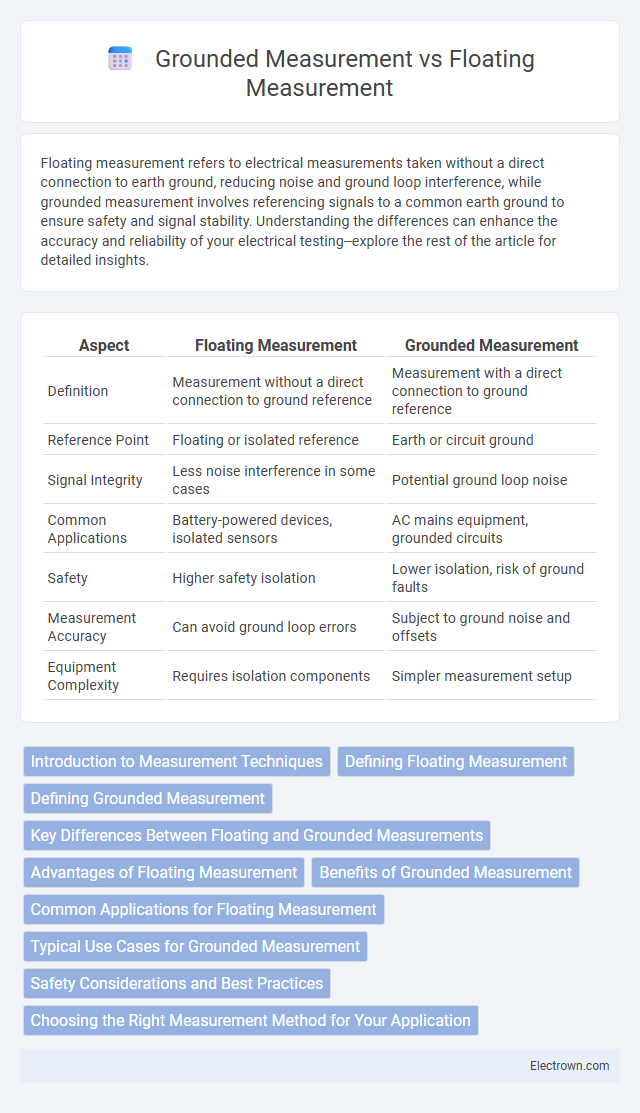Floating measurement refers to electrical measurements taken without a direct connection to earth ground, reducing noise and ground loop interference, while grounded measurement involves referencing signals to a common earth ground to ensure safety and signal stability. Understanding the differences can enhance the accuracy and reliability of your electrical testing--explore the rest of the article for detailed insights.
Table of Comparison
| Aspect | Floating Measurement | Grounded Measurement |
|---|---|---|
| Definition | Measurement without a direct connection to ground reference | Measurement with a direct connection to ground reference |
| Reference Point | Floating or isolated reference | Earth or circuit ground |
| Signal Integrity | Less noise interference in some cases | Potential ground loop noise |
| Common Applications | Battery-powered devices, isolated sensors | AC mains equipment, grounded circuits |
| Safety | Higher safety isolation | Lower isolation, risk of ground faults |
| Measurement Accuracy | Can avoid ground loop errors | Subject to ground noise and offsets |
| Equipment Complexity | Requires isolation components | Simpler measurement setup |
Introduction to Measurement Techniques
Floating measurement techniques involve measuring electrical signals without a direct connection to ground, allowing for accurate detection of voltage differences in isolated or high-impedance circuits. Grounded measurement, by contrast, uses a common reference point connected to earth ground, simplifying circuit analysis but potentially introducing noise or ground loops. Selecting between floating and grounded measurements depends on the circuit configuration, signal integrity requirements, and safety considerations in electronic testing and diagnostics.
Defining Floating Measurement
Floating measurement refers to a technique where the measurement system's reference point is not connected to the earth ground, allowing it to detect voltage differences between two points without a fixed ground reference. This approach is essential in applications involving isolated circuits or measuring small voltage variations in high common-mode voltage environments. Floating measurement enhances safety and accuracy by preventing ground loops and reducing electrical noise interference.
Defining Grounded Measurement
Grounded measurement refers to electrical measurements taken with one terminal connected to a common reference point, typically earth ground, ensuring stable, noise-free readings. This method improves accuracy and safety by providing a consistent zero voltage reference, minimizing interference from external electromagnetic fields. Your measurement setup benefits from predictable voltage references, making grounded measurement ideal for most industrial and laboratory applications.
Key Differences Between Floating and Grounded Measurements
Floating measurement involves measuring a voltage or signal without a direct reference to the electrical ground, allowing detection of potential differences in isolated circuits. Grounded measurement connects the measurement device's reference point directly to the system ground, providing a stable and common reference for accurate readings. Understanding the key differences helps you choose the right approach for safety, noise reduction, and avoiding ground loops in electrical testing.
Advantages of Floating Measurement
Floating measurement offers the advantage of isolating the measurement device from ground loops and common-mode voltages, enhancing accuracy in complex electrical circuits. It enables safe measurements in high-voltage environments by preventing direct electrical connection to the ground, reducing the risk of short circuits and equipment damage. This method is particularly beneficial in sensitive analog signal acquisition where ground potential differences can introduce noise and errors.
Benefits of Grounded Measurement
Grounded measurement enhances signal integrity by reducing noise and interference through a stable reference point connected to earth ground. This method improves accuracy and repeatability in readings by minimizing potential differences caused by floating voltages. Grounded measurement also offers increased safety in high-voltage applications by providing a controlled path for fault currents.
Common Applications for Floating Measurement
Floating measurement is commonly used in applications where isolation from ground loops is critical, such as in medical instrumentation, audio equipment, and industrial automation systems. It enables accurate voltage readings without reference to earth ground, preventing interference and ensuring safety when measuring signals in high-voltage or multiple grounding environments. This technique is essential for differential measurements and systems requiring high common-mode rejection.
Typical Use Cases for Grounded Measurement
Grounded measurement is commonly used in applications requiring precise and stable voltage references, such as power supply testing, circuit debugging, and sensor calibration. This method ensures consistent signal integrity by minimizing noise and interference through a common reference point to ground. Your electronic diagnostic tasks benefit from grounded measurement's reliability when monitoring voltage levels in complex circuits.
Safety Considerations and Best Practices
Floating measurement techniques enhance safety by isolating the measurement equipment from ground loops, reducing the risk of electric shock and protecting sensitive instruments from voltage spikes. Grounded measurement systems require careful attention to proper grounding and bonding to prevent hazardous potential differences and ensure accurate readings. You should always follow industry standards and use appropriate insulation and protective devices to maintain safe practices in both measurement methods.
Choosing the Right Measurement Method for Your Application
Floating measurement offers isolation from ground loops and reduces noise interference, making it ideal for sensitive electronics and high-voltage environments. Grounded measurement provides stable reference points essential for accurate voltage and current readings in low-noise, controlled settings. Selecting the right method depends on factors like circuit configuration, noise susceptibility, and safety requirements to ensure optimal accuracy and protection.
floating measurement vs grounded measurement Infographic

 electrown.com
electrown.com